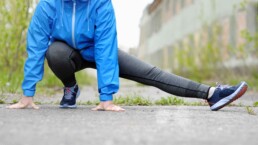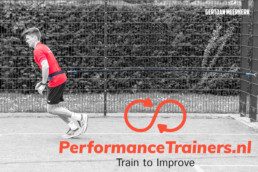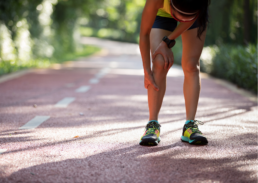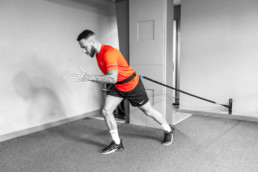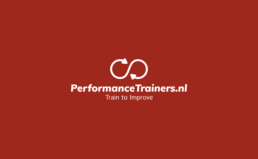Sprint training #4 Hamstring training
Sprint training #4 Hamstring training to sprint faster
Much literature is written about the function of the hamstring during sprinting. Hegyi(2) wrote in 2019 that there is already a lot of isometric hamstring activity in the biceps femoris at 75% of your speed. So your hamstrings play an important role during sprinting.
(info graphics YLMSportscience https://ylmsportscience.com)
Higashihara (4) also writes that there is a high activity of the hamstrings during acceleration and sprinting. During the first meters of your sprint, the acceleration phase, you will see that there is a difference in hamstring activation between the different phases of your running. This study shows that during the acceleration phase, the peak force on the biceps femoris is greater due to the active extension of the hip. While during maximum speed the forces on the semitendinosis due to the knee flexion and extension are again higher. This shows that training the hamstring both over the hip and over the knee can be very important for sprinting, as it provides support in multiple phases of the movement.
(info graphics YLMSportscience https://ylmsportscience.com)
V Hooren and vd Bosch published a nice article in 2017 in which the question is asked which activity takes place in the hamstring during running. According to that research, people often speak of a small union of the muscle (eccentric contraction) during running, whereby they ask the question whether this comes from the muscle itself or whether it is more lengthening of tendon tissue. This would mean that the length of the muscle remains the same as it provides force (isometric contraction).
Because this question is not yet clearly answered in the literature, we have exercises for both contraction forms ;).
So we at Performance trainers advise you: strengthen your hamstrings and improve your sprinting/running!
Check our shop for the ideal training materials to improve your sprint speed!
Isometric Shapes:
glute bridge walk out:
Single leg hop out:
Eccentric shapes:
Single leg deadlift:
Single leg deadlift stiff swing to front knee lift
Deadlift:
- How muscles maximize performance in accelerated sprinting Pandy et al (2021)
- Hamstring activity at different running speeds Heghi MSSE (2019)
- Mechanics of the Human Hamstring Muscles during Sprinting SCHACHE, AG, TW DORN, PD BLANCH, NAT BROWN, and MG PANDY. Mechanics of the Human Hamstring Muscles during Sprinting. med. sci. Sports Exercise, Vol. 44, no. 4, pp. 647–658, 2012
- Hamstring activation acceleration vs maximum speed phases of printing Higashihara et al. J sport sci 2017.
- Is there really an eccentric action of the hamstrings during the swing phase of high speed running? Part I: A critical review of the literature Bas v Hooren Journal of Sports Sciences (September 2017 )
- https://ylmsportscience.com
Sprint Training #2 Sprinting with resistance
Sprint training: Sprinting with resistance
During the game sports there is a lot of sprinting with competitions. With explosiveness training or sprint training, a lot of profit can be achieved.
Football players run 12 kilometers in 90 minutes, of which 200 sprints (2). Hockey players run approximately 20 kilometers (3) in 70 minutes with an average sprint distance of 14-16 meters (4). In gymnastics, many parts start with a sprint and then convert this speed into height for a jump (7)(8). Where in athletics, the sprint is a normal competition part with 100, 200 and 400 meters sprint(7).
Because sprinting is an important part of many sports, it seems useful to look at how we can improve this. This can be done through sprint training with resistance, strength training, core training and technique training.
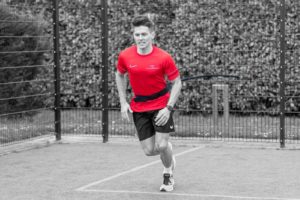
What does science say?
In this blog we are going to talk about sprinting with resistance. Moya-Ramon (2020) did research on 20 young tennis players (16-17 yrs). The players were divided into 2 groups, the sprinting with resistance group and the conventional group. The groups were extensively tested:
- 5-10-20 meter sprint test
- Modified 5-0-5 Agility Test
- Vertical jump test
- Long jump test from position
- Repeated jumping ability shutle test
The groups both followed the same sprint program:
- Sprint forward
- Backwards
- Multidirectional sprints
With 25s of rest between repetitions and 2-3 minutes of rest between sets.
Result
The result of the study shows that the sprint training itself gave physical improvement in the tennis players. In addition, it shows that sprinting with resistance has a slightly better effect on the 5m sprint and horizontal jump. This suggests that if you want to improve your short-term acceleration, you should train with extra resistance through a resistance band.
Sprint trainer pro exercises
Check our shop for the resistance bands set and sprint trainer Pro and start with the following sprint exercises:
Sprinting with resistance:
Check us out Youtube Channel for more core training and functional strength training.
- Moya-Ramon et al J Hum Kin 2020 Effects of Resisted Vs. Conventional Sprint Training on Physical Fitness in Young Elite Tennis Players
- https://www.voetballoopbaan.nl/nieuws/deze-afstanden-lopen-voetballers-gemiddeld-in-een-wedstrijd
- https://www.jenisport.nl/nieuws/hockey/
- (2014). Impact of Maxiumum Speed on Sprint Performance During High-Level Youth Female Field Hockey Matches: Female Athletes in Motion (FAiM) Study. International Journal of Sports Physiology and Performance, 621-626.
- Caroline de Reus (2016) the influence of strength training on the sprint speed of hockey players
- Cronin, J., & Hansen, K. (2005). Strength and Power Predictors of Sports Speed. Journal of Strength and Conditioning Research, 349-357.
- https://beterturnen.nl/clusk-binnen-het-turnen/
- Van den Berg, T. (1996).gymnastics in pictures. Publisher de Vrieseborch
- https://www.atletiek.nl/over-atletiek/spreekbeurt-informatie/onderdelen
Sprint training #3 Strength training
Verbeter je sprint met krachttraining!
In blog #3 schreven we over sprint training en welke vormen er zijn, in blog #4 hebben we het sprinten met weerstand uitgediept zodat je hier lekker mee aan de slag kon. Nu Blog #7 alweer waarin we je meenemen in het doen van krachttraining om je sprint en explosiviteit te verbeteren. In veel sporten heb je veel voordeel als je snel kan sprinten/rennen of hoog kan springen, hiermee kan jij voor jezelf en het team het verschil gaan maken!
Welke spieren spelen een belangrijke rol bij het sprint training?
In 2021 werd er een mooi artikel gepresenteerd waarin onderzoek werd gedaan welke spieren en een belangrijke rol speelde bij het accelereren/sprinten(1). In het onderzoek werd gekeken naar de kuitspieren, spieren van het bovenbeen en de bilspieren. Hieruit blijkt dat deze spieren hierbij een belangrijke rol spelen.
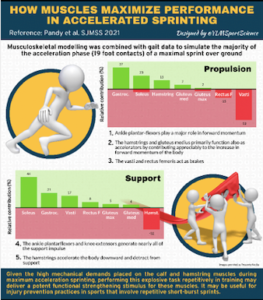
De kuit spieren, hamstrings en bilspieren spelen een belangrijke rol bij de acceleratie tijdens het sprinten, en de spieren van de bovenbenen werken met als remmers tijdens het sprinten.
Hiervoor hebben wij specifieke oefeningen die hierbij kunnen helpen!
How do you best fill in your sprint training?
For your sprint training, here are some exercises that will help with this.
Train your calves:
During the soleus with the aquatrainer from the archer's position, you mainly train the thigh and hip muscles. By using the aqua trainer we also train trunk stability and arm strength.
Attention points for this exercise:
- Take a big step forward and lower your back knee to just above the ground
- Lift the heel of your front foot as high as possible
- Keep the back straight (don't pull hollow)
Train your hamstrings:
During the Single leg bridge with chest press explosive with aqua trainer you mainly train the thigh, hip muscles, chest and shoulder. By using the aquatrainer pro we also train trunk stability.
Attention points for this exercise:
- Lie on your back, grab the aquatrainer with both hands and hold it on your chest. Do the pro band short around your knees.
- Lift 1 leg straight and keep your knees at the same height.
- Explosively lift the buttocks off the mat and stretch the aquatrainer upwards at the same time.
- Keeps the trunk stable
- Then lower the buttocks and aquatrainer
Sprinting with resistance:
During the Squat jump sprint + sprint trainer pro you mainly train leg muscles. By using the sprint trainer do you have extra resistance?
Attention points for this exercise:
- Stand on 2 legs with sprint trainer band around the hips
- Jump on 1 legs as high as possible
- Try to land as softly as possible by sinking your knee well and staying on the front feet
- Sprint forward as quickly as possible after landing
Running injuries
In blog #5 over Sportblessures 2020 schreven we dat in 2020, mede door de lockdown, het aantal hardloop blessures fors is toegenomen (1). Daarom leek het ons wel handig om eens de literatuur in de duiken. Zodat we kunnen laten zien wat er bekend is over hardloop blessures. Hoe ontstaan hardloop blessures en wat zouden we er zelf aan kunnen doen om dit te voorkomen.
Hoeveel hardloop blessures zijn er dan eigenlijk?
In 2020 zijn er 1,1 miljoen blessures door hardlopen gemeld. Dat is 22% van het totaal aantal blessures (in 2019 stond hardlopen op plek 3 met 780.000 blessures)(1). Deze forse toename beschreven we eerder aan de toename van hardloop activiteiten door de lockdown. Uit onderzoek blijkt dat er op de 1000 hardloopuren die gemaakt worden er 7,5 blessure ontstaan. Waaruit blijkt dat het aantal blessures een stuk hoger zijn dan bijvoorbeeld in vergelijking met veldvoetbal dat 5,6 blessures telt per 1000 gespeelde/getrainde uren.
Uit de afbeelding blijk dus dat de toename komt doordat we meer zijn gaan hardlopen, maar ook dat het risico op een blessure hoger is dan bij veldvoetbal en fitness.
Hoe denken we zelf dat hardloop blessures ontstaan?
Bijzonder om te horen in de sportfysiotherapie praktijk is dat de redenen voor het ontstaan van hardloop blessures enorm uiteenloopt. Niet alleen in de praktijk horen we dit, maar geloof het of niet, er is zelfs onderzoek naar gedaan(3). In het onderzoek zijn 95 recreatieve hardlopers geïnterviewd, deze waren tussen de 19-71 jaar oud en hadden gemiddeld 5.5 jaar hardloop ervaring. Bovendien had 45% van de deelnemers ook daadwerkelijk ervaring met een hardloopblessure gehad. In het onderzoek hebben de gekeken naar intrinsieke en extrinsieke factoren. De meest genoemde extrinsieke factoren voor het ontstaan van blessures waren hierin: “ niet rekken” “overmatig trainen” “onvoldoende warming-up’ “gebrek aan kracht” en “het dragen van verkeerde schoenen”. Intrinsieke factoren die werden genoemd: “geen respect voor het fysieke limiet van het lichaam” en “voet type verandering”(3).
Nu we weten wat we vooral zelf denken laten we eens kijken naar andere literatuur!
Wat weten we over het ontstaan van hardloopblessures?
Opvallend is dat van alle hardloopblessures 79% een blessure aan de onderste extremiteiten was, vooral aan het been (30%) en de knie (26%) (2)
Recent is er een mooi artikel gepubliceerd over risico factoren voor overbelasting bij korte en lange afstandslopers (5).
Het eerder hebben gehad van een hardloopblessure werd beschreven als een sterke risico factor voor het ontstaan van een nieuwe blessure voor lange afstandslopers, terwijl juist een eerdere blessure die niet ontstaan was door hardlopen een risico gaf bij korte afstandslopers. Een hoger BMI, hogere leeftijd, geslacht (man), geen hardloop ervaring en weinig hardloop meters waren sterke risico factoren voor korte afstand lopers.
- https://www.veiligheid.nl/sportblessures/actueel/forse-toename-hardloopblessures-door-lockdown-in-2020
- https://www.sportenbewegenincijfers.nl/kernindicatoren/blessurerisico
- What Do Recreational Runners Think About Risk Factors for Running Injuries? A Descriptive Study of Their Beliefs and Opinions
- “Risk factors for overuse injuries in short- and long-distance running: A systematic review.” Dennis van Poppel, Maarten van der Worp, Anouk Slabbekoorn, Sylvia S.P. van den Heuvel, Marienke van Middelkoop, Bart W. Kroes, Arianne P. Verhagen, Gwendolyne G.M. Scholten-Peeters. Uit de Journal of Sport and Health Science episode 10 (2021) pag. 14-28
- https://www.psychfysio.nl/risicofactoren-voor-het-ontstaan-van-hardloopblessures/
Sports injuries
Waar er wordt gesport ontstaan er sportblessures. Veiligheid.nl (1) heeft over het jaar 2020 een onderzoek gedaan naar het aantal, soort en sport specifieke blessures. Goed om te zien is dat ondanks
 de corona maatregelen en geen drastische afname is in het sportgedrag in Nederland.
de corona maatregelen en geen drastische afname is in het sportgedrag in Nederland.
Aantallen:

In 2020 is te zien dat het aantal sportblessures minder is dan de jaren daarvoor. Ook wel te verklaren omdat door de corona maatregelen het sportklimaat in Nederland veelal toch drastisch is gewijzigd. Zo is er in de blessures een duidelijke verschuiving te zien van minder georganiseerde team sporten naar meer individuele duursporten, wandelen en fietsen.
Hierbij moet opgemerkt worden dat deze daling van het aantal blessures logisch is gezien er bij de trainingen en wedstrijden bij de teamsporten een hoger risico is op blessures dan bij de (vaak) lager intensieve duursporten.
Hardlopers hebben de meeste blessures:
Waar in eerdere jaren veldvoetbal de sport was met de meeste blessures, werd deze plaats in 2020 ingenomen door hardlopen met 1,1 miljoen blessures, 22% van het totaal (in 2019 stond hardlopen op plek 3 met 780.000 blessures). Door de coronamaatregelen was veldvoetbal, vooral competitiewedstrijden, maar in beperkte mate mogelijk. Hardlopen was daarentegen in tijden
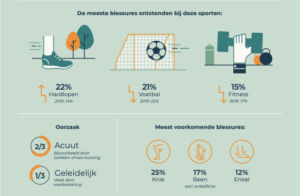
van lockdown erg populair, wat een stijging van het aantal blessures tot gevolg had. Dit komt naast dat er meer is hardgelopen ook doordat veel mensen zijn begonnen met hardlopen. Een beginnende sporter loopt vaak meer risico op een blessure.
Ondanks de blessures cijfers zijn wij van mening dat het belangrijk is om te blijven sporten! Blijf werken aan je fitheid en vitaliteit, vooral in deze periode. Ook je immuunsysteem is gebaad bij sportactiviteiten.
Onze sportproducten op Shop - PerformanceTrainers.nl en onze sportschema's op Training schedules - PerformanceTrainers.nl kunnen hierin helpen.
Wil je meer weten over hardloopblessures lees onze blog hierover!
- https://www.veiligheid.nl/sportblessures/actueel/forse-toename-hardloopblessures-door-lockdown-in-2020
- “Risk factors for overuse injuries in short- and long-distance running: A systematic review.” Dennis van Poppel, Maarten van der Worp, Anouk Slabbekoorn, Sylvia S.P. van den Heuvel, Marienke van Middelkoop, Bart W. Kroes, Arianne P. Verhagen, Gwendolyne G.M. Scholten-Peeters. Uit de Journal of Sport and Health Science episode 10 (2021) pag. 14-28
Sprint training #1
Many athletes want to improve their speed and explosiveness. Sprint training and strength training are some methods that can contribute to this. In this blog you will find some recent studies explained and how you can get started.
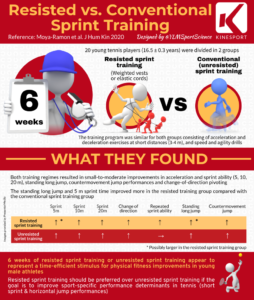
Sprint training by sprinting with resistance:
Sprinting with resistance is a good way to improve your sprint. Research among 20 young tennis players shows that short sprints and jumping power improve when sprinting with resistance. A weight vest or resistance band was used for this (Moya-Ramon et al J Hum Kin 2020). After training for 6 weeks of short sprints of 3-4 meters and after that had an improvement. Training with resistance bands or sprint trainer can effectively contribute to your sprint training.
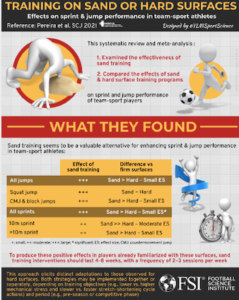
Sprint training on different surfaces:
Can the surface you sprint on be of added value for your performance? Apparently yes, research shows that sprint training 2-3x a week for 4-8 weeks in the sand can have a positive effect on your sprint and jumping power (Pereira et al 2021). Before everyone starts building a sandbox. In addition to resistance training (strength training), sprint training on a hard surface also improves the ability to sprint and jump.
Improve your sprint training through strength training?
Strength training is a common way to get stronger and improve your ability to sprint. But what exactly should you do? Research (Pandy et al 2021) shows that the calves and hamstrings have to provide a lot of power during sprinting. So it seems wise to train them properly. In addition, the glutes play an important role, larger glutes and other hip extensors provide a more powerful push-off and therefore a greater sprint ability (Miller et al 2020). You can train your hamstrings well with, for example, a glutebridge and make it even more challenging with the aqua trainer.
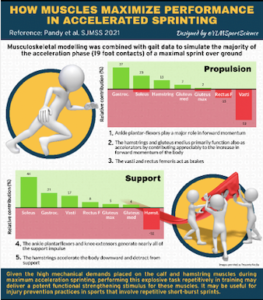
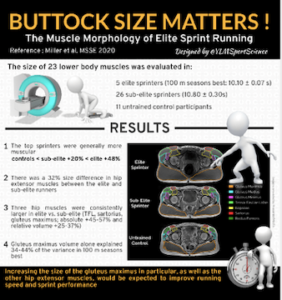
How do you best fill in your sprint training?
For your sprint training, here are some exercises that will help with this.
Train your calves:
During the soleus with the aquatrainer from the archer's position, you mainly train the thigh and hip muscles. By using the aqua trainer we also train trunk stability and arm strength.
Attention points for this exercise:
- Take a big step forward and lower your back knee to just above the ground
- Lift the heel of your front foot as high as possible
- Keep the back straight (don't pull hollow)
Train your hamstrings:
During the Single leg bridge with chest press explosive with aqua trainer you mainly train the thigh, hip muscles, chest and shoulder. By using the aquatrainer pro we also train trunk stability.
Attention points for this exercise:
- Lie on your back, grab the aquatrainer with both hands and hold it on your chest. Do the pro band short around your knees.
- Lift 1 leg straight and keep your knees at the same height.
- Explosively lift the buttocks off the mat and stretch the aquatrainer upwards at the same time.
- Keeps the trunk stable
- Then lower the buttocks and aquatrainer
Sprinting with resistance:
During the Squat jump sprint + sprint trainer pro you mainly train leg muscles. By using the sprint trainer do you have extra resistance?
Attention points for this exercise:
- Stand on 2 legs with sprint trainer band around the hips
- Jump on 1 legs as high as possible
- Try to land as softly as possible by sinking your knee well and staying on the front feet
- Sprint forward as quickly as possible after landing
In top sport and physiotherapy, a lot of training and rehabilitation is done with the Aquatrainer! but why?
Trainen met de aquatrainer is geschikt voor iedereen, je kan immers zelf de weerstand bepalen door de hoeveelheid water wat je erin doet. Daarnaast kan je variëren in moeilijkheid van de oefeningen. Voor sommige zal het uitvoeren van een backsquat met aquatrainer voldoende trainingseffect geven en voor anderen zal dit op 1 been moeten. Het kiezen van weerstand en oefening ook weer afhankelijk van het doel wat je koppelt aan je oefening.
Wat is er zo speciaal aan trainen met de aquabag?
Trainen met de aquabag is bijzonder, omdat het water, en daarmee het gewicht, zich continue verplaatst. Hierdoor is het extra lastig om je balans te bewaren tijdens de oefeningen. De “extra last” die de aquatrainer geeft, heeft eigenlijk aan maar voordelen, hierdoor zal je namelijk het lichaam harder moeten werken om in balans te blijven. Dit hardere werken gaat je lichaam merken. De spieren, pezen en gewrichten zullen signalen af gaan geven dat er meer moeite is om je balans te bewaren. Hierdoor gaan andere spieren en spiervezels activeren om de stabiliteit te bewaren. Dit gebeurt lokaal als je bijvoorbeeld een backsquat doet train je vooral je bovenbeen en heup spieren maar als je dit doet met de aquatrainer (https://youtu.be/1DLP1mJp75I ) dan moet je meer moeite doen om de knie en heup stabiel te houden omdat het water zich continue verplaatst. Ook in de rest van het lichaam zullen spieren gaan activeren, door het gebruik van de aquatrainer moet je ook je rompspieren activeren om de stabiliteit te bewaken. Tijdens het dagelijks leven en het sporten gebeurt dit ook en hoe beter spieren samenwerken (co-contracties) hoe beter we kunnen bewegen.(1)
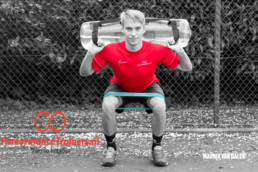
Trainingsdoel:
Als je krachttraining gaat doen met de aquatrainer is het heel belangrijk te bepalen met welk doel je dit gaat doen. Verwijzingen naar de weerstand kan je ook vinden in onze trainingsschema’s. Wil je namelijk krachttrainen dan zal je weerstand hoog (60-70-80%) moeten zitten, maar wil je explosiviteit trainen, dan zal je ook explosief moeten kunnen bewegen, dan zal de weerstand lager moeten zijn (30-60%). Weinig weerstand in de aquabag voelt soms alsof er weinig in het lichaam gebeurt, maar als jij bewegingen doet op hoge snelheid zal het behouden van je stabiliteit (lokaal en globaal) ook lastiger zijn. Hierdoor krijg je een hoge mate van co-contracties en preflexen.
Co-contracties:
Co-contracties is het samenwerken van spieren om te zorgen voor stabiliteit. Dit is belangrijk voor het bewegen tijdens het dagelijks leven en voor het voorkomen van blessures(2)(3)(4). Voor je knie is het bijvoorbeeld belangrijk dat je hamstring en quadriceps goed samenwerken, er moet dus een goede co-contractie plaatsvinden. Uit onderzoek blijkt dat je tijdens een 2 benige squat weinig co-contracties hebt omdat de mate van stabiliteit vrij hoog is, maar als je dit op 1 been uitvoert (https://youtu.be/Q-yZF_cFPfo ), met minder stabiliteit, vind er meer cocontractie plaats tussen de hamstring en quadriceps. Je ziet in de video’s ook duidelijk het verschil in moeite die gedaan wordt om de stabiliteit te behouden.
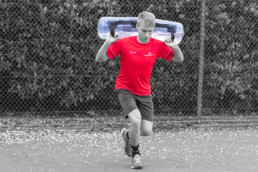
Beter bewegen?
Hoe meer en beter de co-contracties hoe beter spieren samen gaan werken, hierdoor elimineer je “beweeg fouten” en bevorder je de taak performance (4).
Wil trainen met de aquatrainer?
Hier hebben wij een aqua bag die tot 25 liter gevuld kan worden, wat voor iedereen, beginner of gevorderd, een ideale toevoeging en uitdaging van het trainen is.
Of zien welke oefeningen je er mee kunt doen?
Bekijk al onze trainingsvideo’s en abonneer je op ons YouTube kanaal!
Bronnen gebruikt voor dit stuk
- Bosch, F. (2010). Krachttraining en coördinatie een integratieve benadering.2010 uitgevers ISBN:9789490951108.
- Rachel Dedinsky (2016) EXERCISES THAT FACILITATE OPTIMAL HAMSTRING AND QUADRICEPS CO-ACTIVATION TO HELP DECREASE ACL INJURY RISK IN HEALTHY FEMALES: A SYSTEMATIC REVIEW OF THE LITERATURE
- DeMers, M.S., Hicks, J.L., & Delp, S.L. (2016). Preparatory co-activation of the ankle muscles may prevent ankle inversion injuries . Journal of biomechanics, Doi:10.1016/j.jbiomech. 2016.11.002
- James B. Heald (2018) Increasing muscle co-contraction speeds up internal model acquisition during dynamic motor learning.
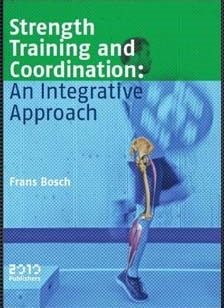
Welcome to PerformanceTrainers.nl
Train to Improve,
From our own passion to continuously improve yourself and the curiosity for new developments in the field of sports and fitness, we started Performance Training.
With Performance Trainers we would like to share our acquired knowledge and experiences with you, so that you can achieve your goal!
To improve your performance, you have to train to want to improve.
From getting fitter to getting the most out of your sports ability. Everything starts with your why!
Start with Why by Simon Sinek is a great way to make your path to improvement visible. (Link- Golden Circle Theory)
It starts with your goal (WHY), from that you make a game plan (HOW) and perform this task (WHAT).
You determine your goal (Improve your Game), we help you in making a game plan. You carry out your training sessions with the help of the videos, schedules and materials from the webshop. This ensures that you get results and improve yourself.
“Start to Improve your Game”
Welcome to Performance Trainers

